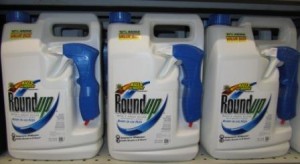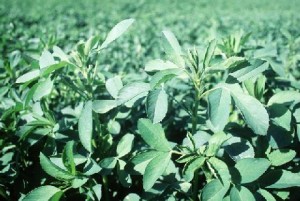Glyphosate is already in our food, air, and water: What is it and why should we care?
 Have you heard of glyphosate? Glyphosate is an herbicide that kills plants, almost all plants. But if you haven’t heard of glyphosate, you have probably heard of Roundup and have seen the clever TV commercials showing weeds wilting and dying–touted as the perfect solution to get rid of weeds in your driveway or around your patio. It’s available just about everywhere–your local hardware or home and garden store. Roundup is a brand name for a herbicide containing glyphosate, which was created and patented by Monsanto in the 1970s, although patent rights have expired and glyphosate is now used under other brand names in addition to Roundup. Glyphosate is a non-selective herbicide, meaning it kills almost all plants; it is absorbed through the leaves and spreads throughout the plant, including the roots and seeds. Glyphosate is systemic; it can’t be washed off because it’s inside the plant. According to the National Pesticide Information Center maintained by the University of Oregon, glyphosate kills by preventing the plant from making proteins needed for growth; it stops an enzyme pathway, the shikimic acid pathway, which is found only in plants and some microorganisms; therefore, glyphosate not only kills plants but also microorganisms.
Have you heard of glyphosate? Glyphosate is an herbicide that kills plants, almost all plants. But if you haven’t heard of glyphosate, you have probably heard of Roundup and have seen the clever TV commercials showing weeds wilting and dying–touted as the perfect solution to get rid of weeds in your driveway or around your patio. It’s available just about everywhere–your local hardware or home and garden store. Roundup is a brand name for a herbicide containing glyphosate, which was created and patented by Monsanto in the 1970s, although patent rights have expired and glyphosate is now used under other brand names in addition to Roundup. Glyphosate is a non-selective herbicide, meaning it kills almost all plants; it is absorbed through the leaves and spreads throughout the plant, including the roots and seeds. Glyphosate is systemic; it can’t be washed off because it’s inside the plant. According to the National Pesticide Information Center maintained by the University of Oregon, glyphosate kills by preventing the plant from making proteins needed for growth; it stops an enzyme pathway, the shikimic acid pathway, which is found only in plants and some microorganisms; therefore, glyphosate not only kills plants but also microorganisms.
 But Roundup’s success is not from home use, it was the introduction of genetically engineered seeds about twenty years ago that has helped glyphosate become the most widely used herbicide in the U.S. and world-wide. Because Roundup Ready crops created by Monsanto have been genetically engineered to be resistant to glyphosate-containing Roundup, the farmer can spray Roundup on his fields and crops; Roundup will kill the weeds (or any other plant that is not Roundup Ready) but won’t kill the Roundup Ready crops. Although glyphosate’s primary application is on farm crops, it’s also used on forests, lawns, gardens, industrial area weeds, and even on water plants. The EPA estimated that in 2007, agriculture used 180 to 185 million pounds; home and garden use was 5 to 8 million pounds; and industry, commerce, and government used 13 to 15 million pounds. The most common Roundup Ready crops in the U.S. and their approximate crop percentages: soybeans, 94%; corn, 66%; canola, 90%; cotton, 43%; and now also alfalfa.
But Roundup’s success is not from home use, it was the introduction of genetically engineered seeds about twenty years ago that has helped glyphosate become the most widely used herbicide in the U.S. and world-wide. Because Roundup Ready crops created by Monsanto have been genetically engineered to be resistant to glyphosate-containing Roundup, the farmer can spray Roundup on his fields and crops; Roundup will kill the weeds (or any other plant that is not Roundup Ready) but won’t kill the Roundup Ready crops. Although glyphosate’s primary application is on farm crops, it’s also used on forests, lawns, gardens, industrial area weeds, and even on water plants. The EPA estimated that in 2007, agriculture used 180 to 185 million pounds; home and garden use was 5 to 8 million pounds; and industry, commerce, and government used 13 to 15 million pounds. The most common Roundup Ready crops in the U.S. and their approximate crop percentages: soybeans, 94%; corn, 66%; canola, 90%; cotton, 43%; and now also alfalfa.
Although glyphosate is promoted as being benign and not readily absorbed by the soil, studies have found it in our air and in our water. A Spanish study found glyphosate in groundwater. A U.S. study found glyphosate in the air and in rain:
weekly integrated air particle and rain samples were collected during two growing seasons in agricultural areas in Mississippi and Iowa. Rain was also collected in Indiana in a preliminary phase of the study. The frequency of glyphosate detection ranged from 60 to 100% in both air and rain. . . . The frequency of detection and median and maximum concentrations of glyphosate in air were similar or greater to those of the other high-use herbicides observed in the Mississippi River basin, whereas its concentration in rain was greater than the other herbicides. [emphasis mine]
Glyphosate destroys soil quality by killing beneficial soil microorganisms. Robert Kremer, a microbiologist with the USDA’s Agricultural Research Service says that using Roundup Ready crops is “altering the whole soil biology. . . Glyphosate is very systemic in the plant and is being released through the roots into the soil. Many studies show that glyphosate can have toxic effects on microorganisms and can stimulate them to germinate spores and colonize root systems.” Twenty percent of the glyphosate used on plants goes into the soil and can affect subsequent crops and soil quality. Dr. Don Huber, an agricultural scientist and expert in microbial ecology, Professor Emeritus from Purdue University, says that the “widespread use of glyphosate that we see today in agriculture in the United States can ‘significantly increase the severity of various plant diseases, impair plant defense to pathogens and diseases, and immobilize soil and plant nutrients rendering them unavailable for plant use.'” Dr. Huber says that over 40 plant diseases–either new diseases or old ones that used to be easily controlled–are now becoming serious problems due to the detrimental effect on soil microorganisms caused by residues of glyphosate. The ability of glyphosate to kill microorganisms can also affect animals who eat the plants. When the animals eat the genetically engineered crops that have been treated with glyphosate-containing Roundup, the animals’ beneficial gut bacteria are killed, thereby removing the natural resistance to toxins such as botulism. The levels of glyphosate currently permitted in feed are high enough to kill normal biological control organisms such as lactobacillus and alcaligenes. Feeding foods made with Roundup Ready crops to infants could be especially risky because infants don’t yet have full intestinal gut bacteria.
 Dr. Huber’s research has found that genetically engineered Roundup Ready crops contain an organism, completely unknown until now, that can cause infertility and miscarriages in farm animals. The new organism is significant because “it can reproduce, and possesses the rare ability to cause disease in both plants and animals.” [emphasis mine] The potential danger of this new as yet unidentified organism is so great that, in January 2011, Dr. Huber wrote a letter to Secretary of Agriculture Tom Vilsack urging a moratorium on the deregulation of Roundup Ready alfalfa until further research could be conducted. A second letter to the European Commission was written in March 2011 giving more detailed information about the damage caused by glyphosate-containing herbicides on Roundup Ready crops. Dr. Huber’s concerns and those of other scientists have been ignored. Roundup Ready alfalfa was approved for commercial use early in 2011.
Dr. Huber’s research has found that genetically engineered Roundup Ready crops contain an organism, completely unknown until now, that can cause infertility and miscarriages in farm animals. The new organism is significant because “it can reproduce, and possesses the rare ability to cause disease in both plants and animals.” [emphasis mine] The potential danger of this new as yet unidentified organism is so great that, in January 2011, Dr. Huber wrote a letter to Secretary of Agriculture Tom Vilsack urging a moratorium on the deregulation of Roundup Ready alfalfa until further research could be conducted. A second letter to the European Commission was written in March 2011 giving more detailed information about the damage caused by glyphosate-containing herbicides on Roundup Ready crops. Dr. Huber’s concerns and those of other scientists have been ignored. Roundup Ready alfalfa was approved for commercial use early in 2011.
Another major problem with Roundup Ready crops treated with glyphosate is the ability of glyphosate to “immobilize plant nutrients such as manganese, copper, potassium, iron, magnesium, calcium, and zinc so they are no longer nutritionally functional.” Zinc and manganese are up to 50% less effective. Manganese is not only essential to plants, humans and animals need it too. One study has indicated that lack of manganese may be a possible root cause of osteoporosis. The ability of glyphosate to bind up, or chelate, the minerals in plants reduces the nutrition available to the animals and people that eat the plants. In fact, glyphosate was first patented as a chelator in 1964. When a plant is genetically engineered to be glyphosate resistant, it will survive, but it will have a 50 percent reduction in available iron and an 80-90 percent reduction in available manganese and zinc. Tests might show that these minerals, such as manganese, copper, iron or zinc, are there in the plant, but the minerals won’t be available for use by the plant or by the animals or humans who eat the plants.
Michael McNeill, an agronomist, said that some of the problems with increased use of glyphosate are “increasing weed resistance to the herbicide, killing of beneficial soil microorganisms, increasing diseases in plants such as sudden death syndrome in soybeans and Goss’s Wilt in corn and other fungal diseases.” Robert Kremer says that there are “eight different species of glyphosate resistant weeds in Missouri.” There are 21 weeds confirmed world-wide that are now resistant to glyphosate. The techno-agricultural solution to glyphosate resistant weeds is to engineer seeds tolerant to a combination of two or more herbicides, such as Roundup and Dicamba. According to Robert Kremer, continually combatting resistance by adding another herbicide to the mix is “an illogical circle.” Heavy use of Roundup, in combination with genetically engineered crops, has produced these ‘superweeds’ in the U.S. and in other countries as well.
What concerns me the most about glyphosate are the serious and significant health impacts to humans and animals caused by exposure to glyphosate and Roundup Ready crops. Dr. Huber says that glyphosate causes “reproductive failure, infertility, as well as miscarriage for cattle, horses, pigs, sheep, and poultry.” Further, since the effect covers so many animal species, it is also likely to affect humans the same way, and there is evidence that infertility in humans is steadily increasing. Other studies have shown premature aging in animals; cows at two and a half years old have been downgraded at market to a ten-year old cow. A study published in 2010 showed evidence that pregnant women exposed to glyphosate have babies with “congenital malformations, including microcephaly, anencephaly, and cranial malformations. . . In addition, both glyphosate and the commercial herbicide severely affect embryonic and placental cells, producing mitrochondrial damage, necrosis, and programmed cell death . . . with doses far below those used in agriculture.” “Other effects observed include cytotoxicity and genotoxicity, endocrine disruption of the androgen and estrogen receptors, and DNA damage in cell lines.” One study demonstrated that, in fact, Roundup was even more damaging than glyphosate alone, probably because the adjuvants in Roundup “allow a better cell penetration and stabilization of the product [glyphosate].” As you can see, there is increasing evidence of organ and systemic damage from glyphosate and Roundup in humans and animals.
We’ve talked about the damage to plants, animals, and humans–superweeds, the fertility and organ damage in animals, and the malformed babies of pregnant women exposed to glyphosate. How much harm does glyphosate and its hepped-up Roundup need to cause before we recognize that we just can’t go on spraying it in ever-increasing amounts and in ever stronger doses by combining herbicides. If there’s so much potential harm to the soil, plants, animals, and to us and our children, what possible benefits could justify its continued widespread use?
You may also be interested in these related Real Food Houston posts:
It’s Not Pretty Behind the Biotech Veil, an Interview with Howard Vlieger
GMO Crops Fail Again–This Time It’s Bt Corn
Double GM Whammy for the Monarch Butterfly
Why Was an Antibiotic-Resistant GE Potato Approved?
What Does Genetically Engineered (or GMO) Mean?
GMO Foods Should Be Labeled
Sources:
The Organic and Non GMO Report interview with Robert Kremer, Experts say Roundup causing problems in soil, plants, and animals
The Organic and Non GMO Report, interview with Dr. Don Huber, Scientist warns of dire consequences with widespread use of glyphosate
Dr. Mercola’s interview with Dr. Don Huber, The Hidden Epidemic Destroying Your Gut Flora
Carrasco, Andres E., Glyphosate-Based Herbicides Produce Teratogenic Effects on Vertebrates by Impairing Retinoic Acid Signaling
Seralini, G.E., Time- and Dose- Dependent Effects of Roundup on Human Embryonic and Placental Cells
Farm and Ranch Freedom Alliance/GMOs
Additional Information about glyphosate:
Added January 27, 2013: Ji, Sayer, Research: Roundup Herbicide Toxicity Vastly Underestimated
Added May 13, 2013: Ji, Sayer, Is GMO Farming Poisoning The World’s Drinking Water?

Pingback:Food of the United States is a sheer and utter disgrace - Page 31
Pingback:Study finds significant new evidence that GMOs can cause harm | Real Food Houston
Pingback:Are We Sacrificing Our Children to Profits From Glyphosate (Roundup) and Roundup-Ready GE Crops? | Real Food Houston
Pingback:Monsanto wants glyphosate limit in food to be raised up to 150 times | Real Food Houston
Pingback:Is Glyphosate (Monsanto’s Roundup) Used On Wheat? | Real Food Houston
Pingback:Do You Have a Chronic Disease–Diabetes, Hypertension, Cancer, Autism, and more? Glyphosate (in Monsanto’s Roundup) just might be the cause! | Real Food Houston
Pingback:Glyphosate (Monsanto’s Roundup) is Applied to Oats, Not Just Wheat! | Real Food Houston